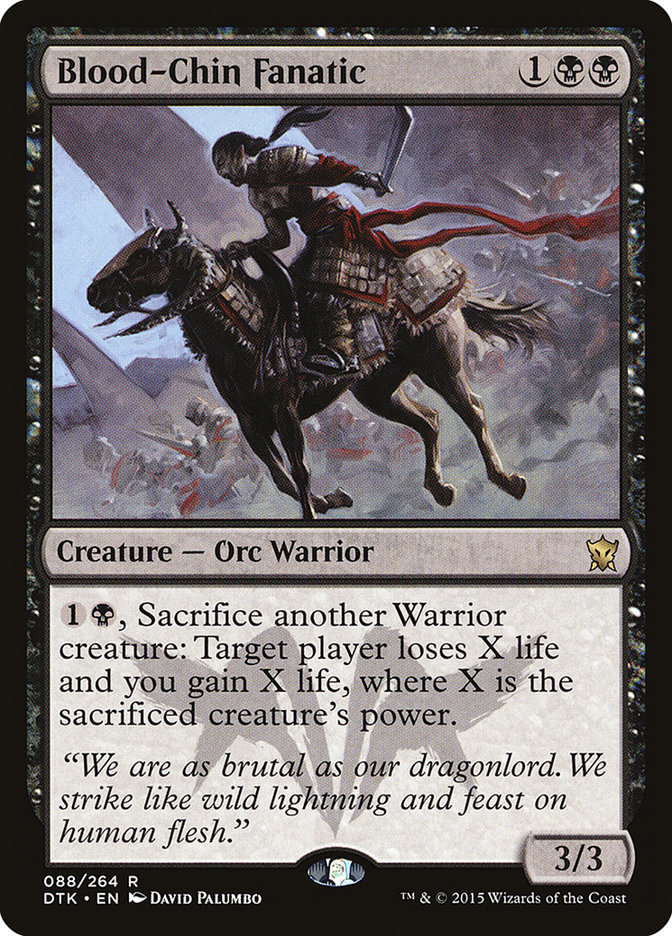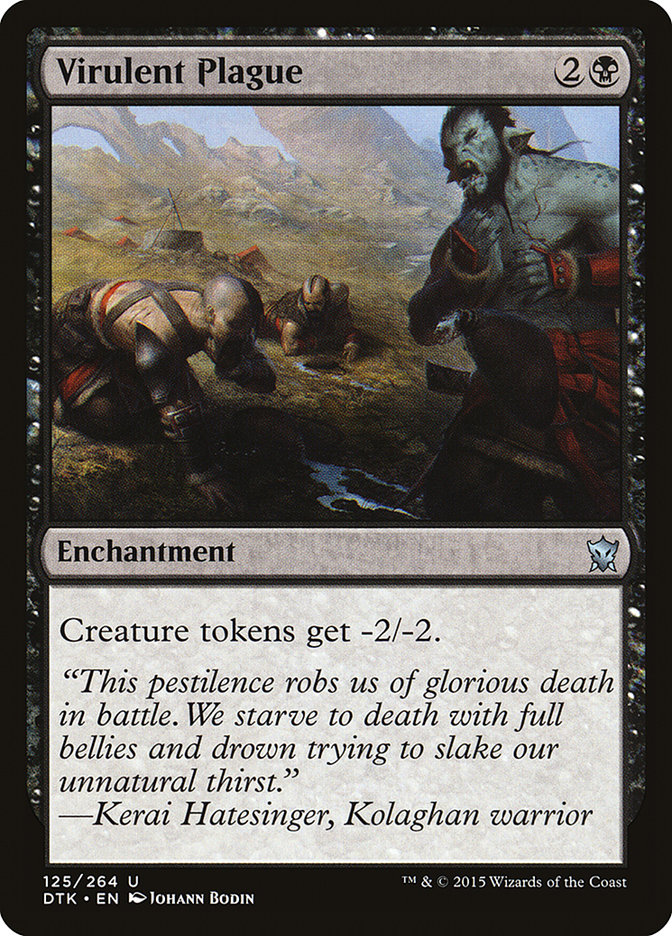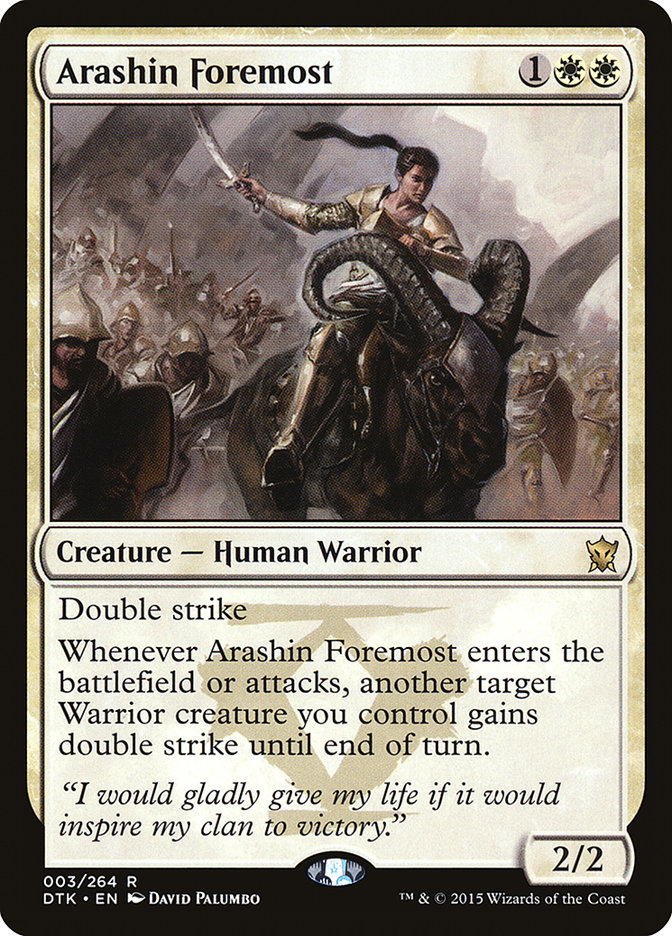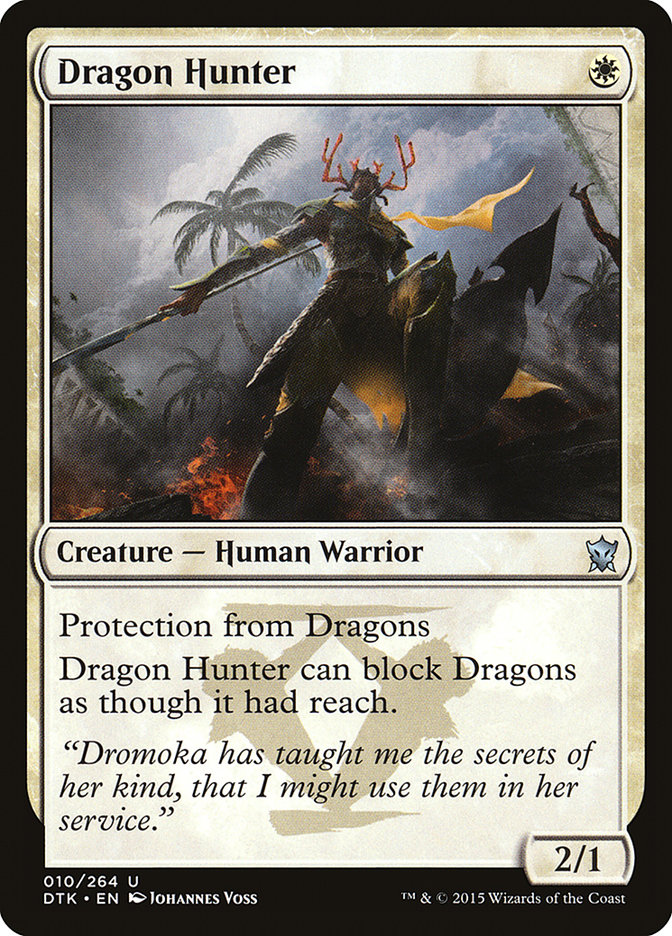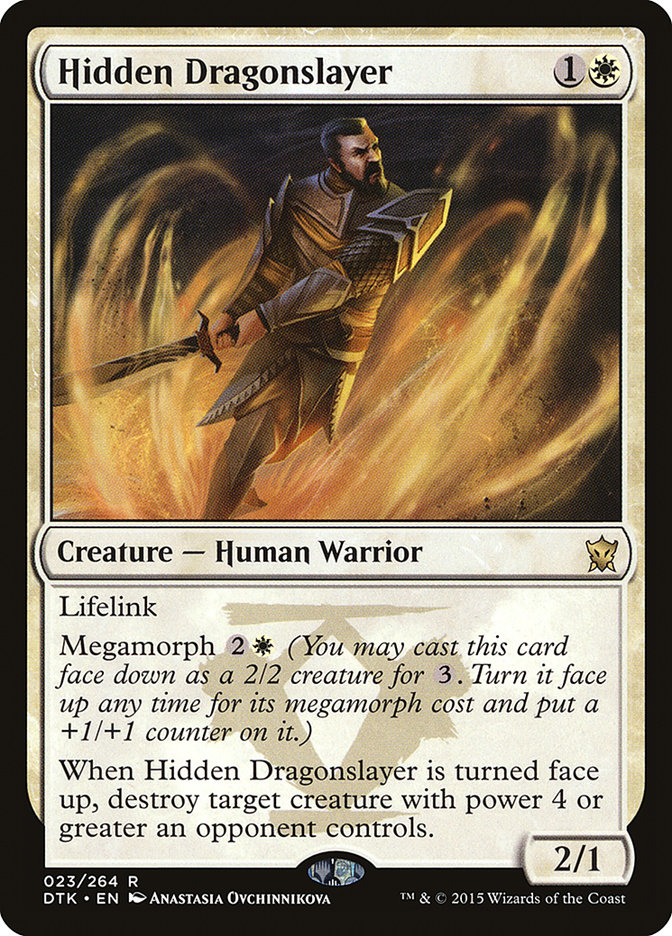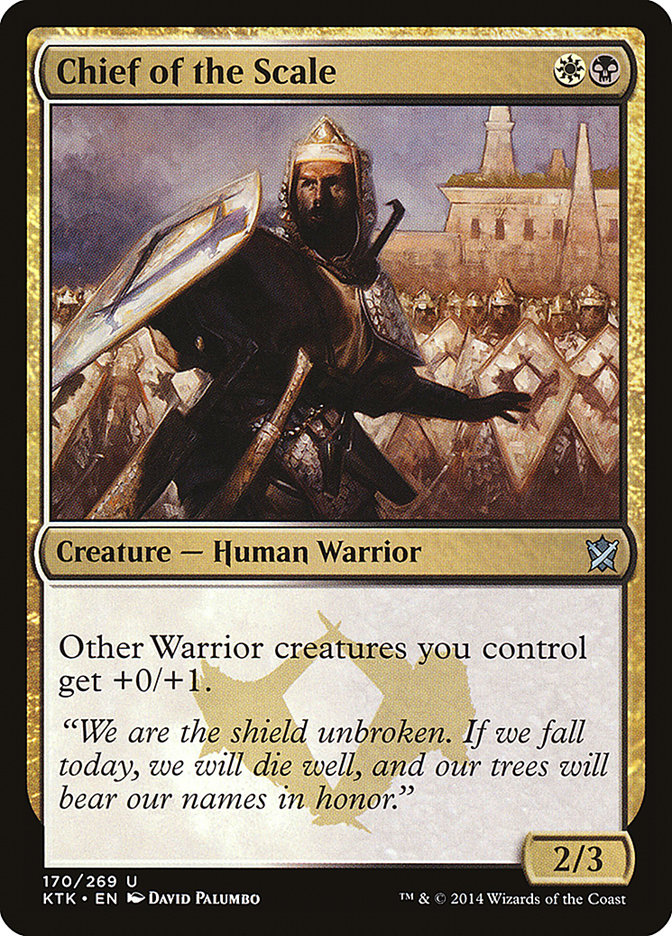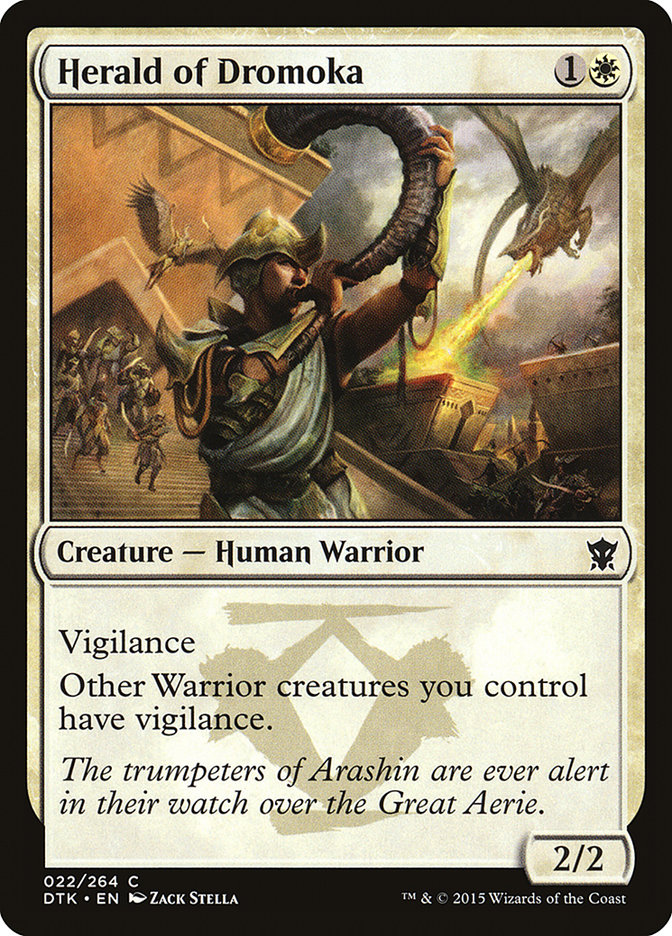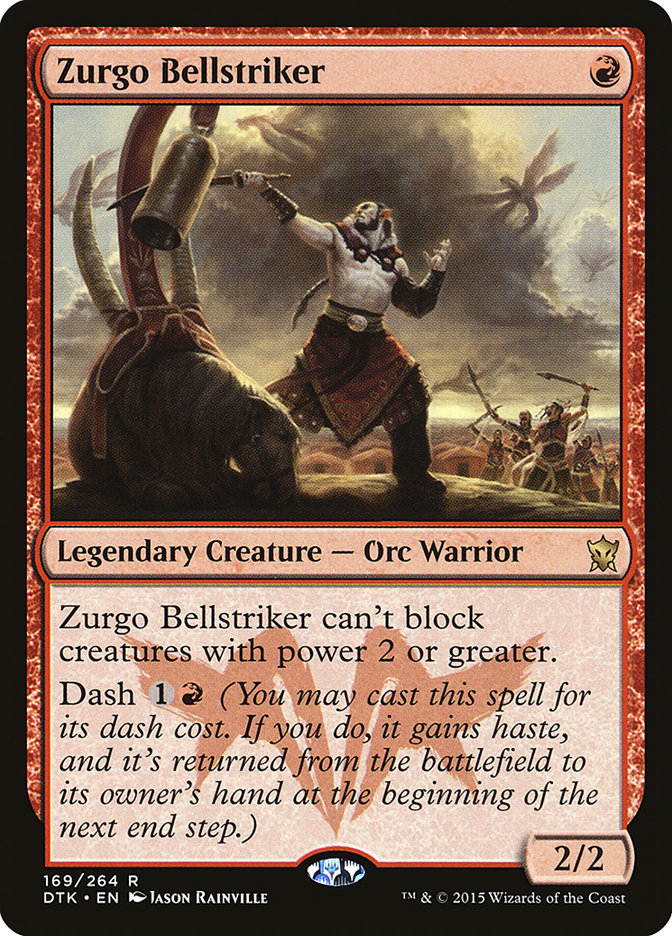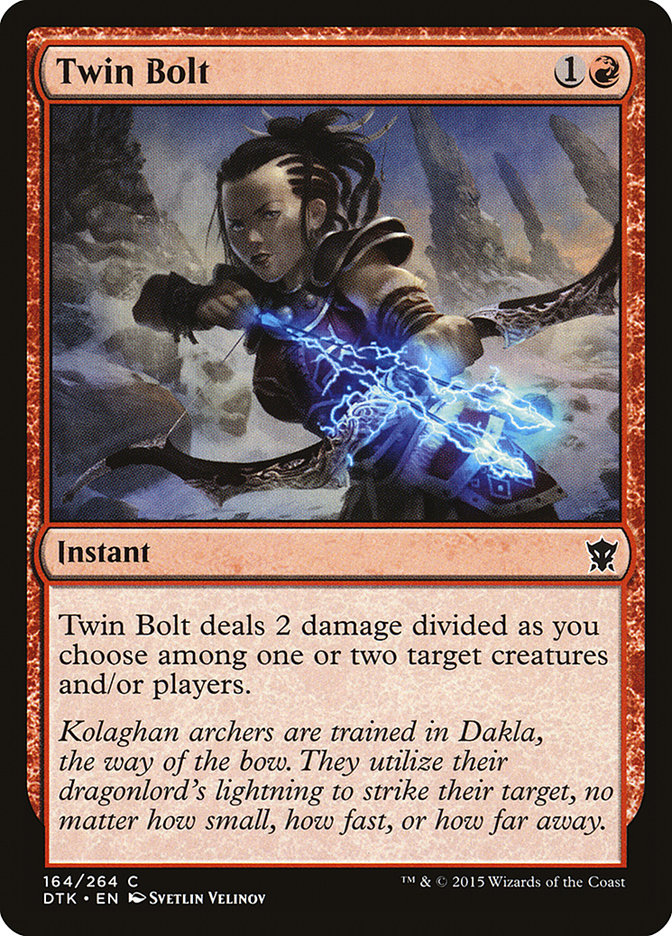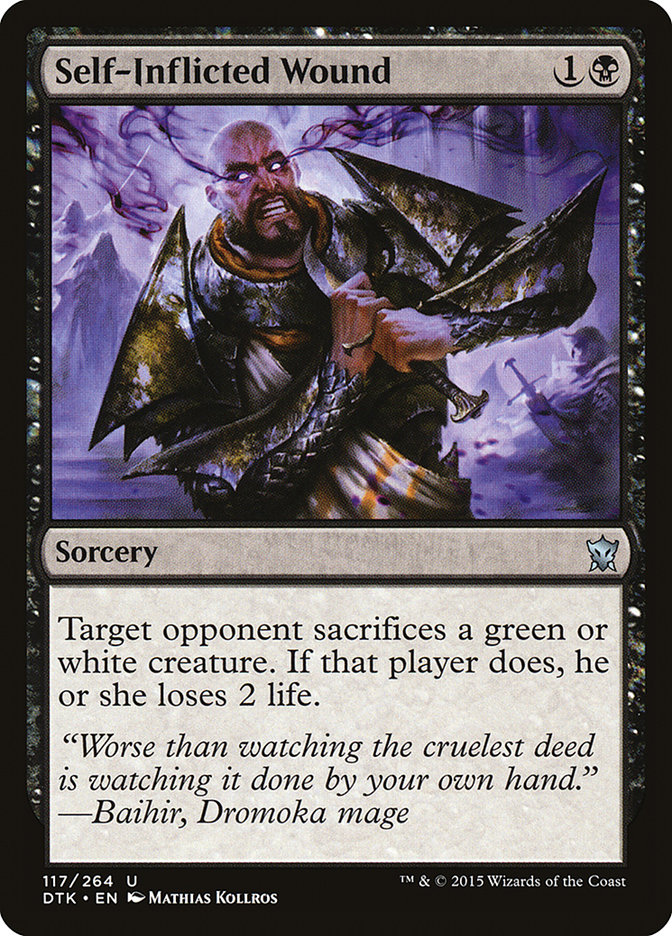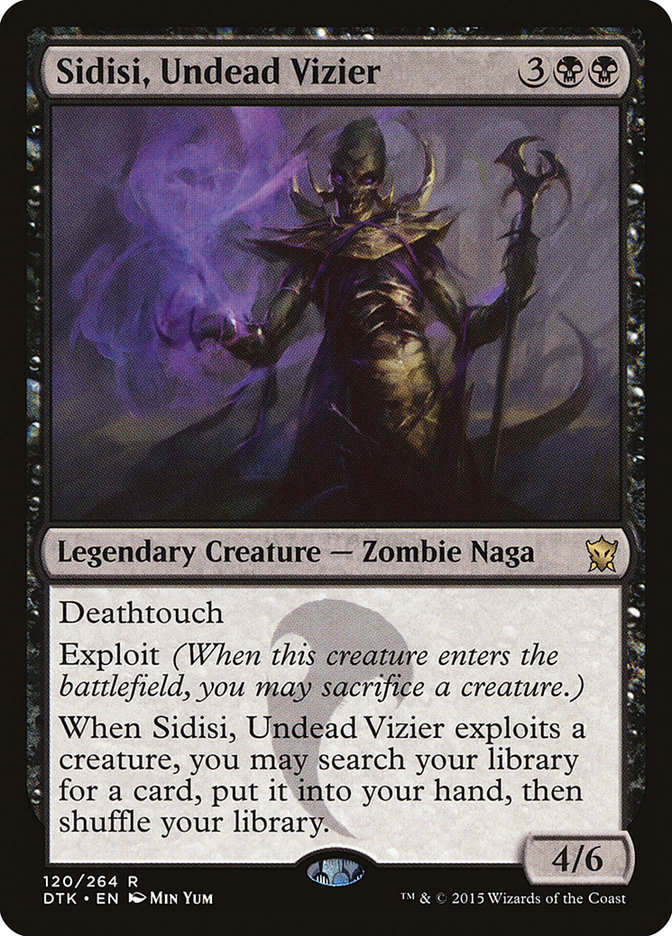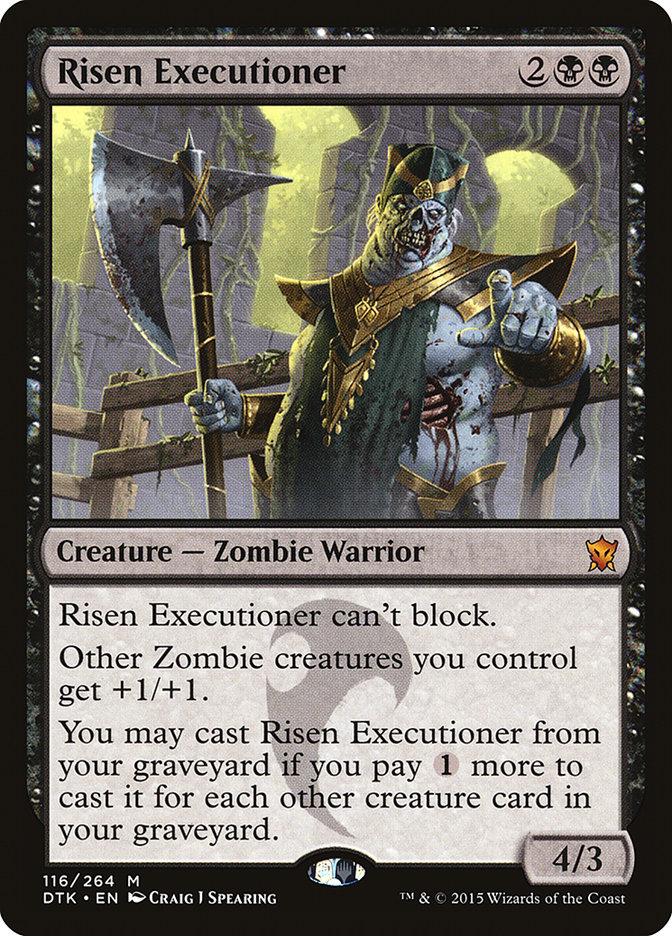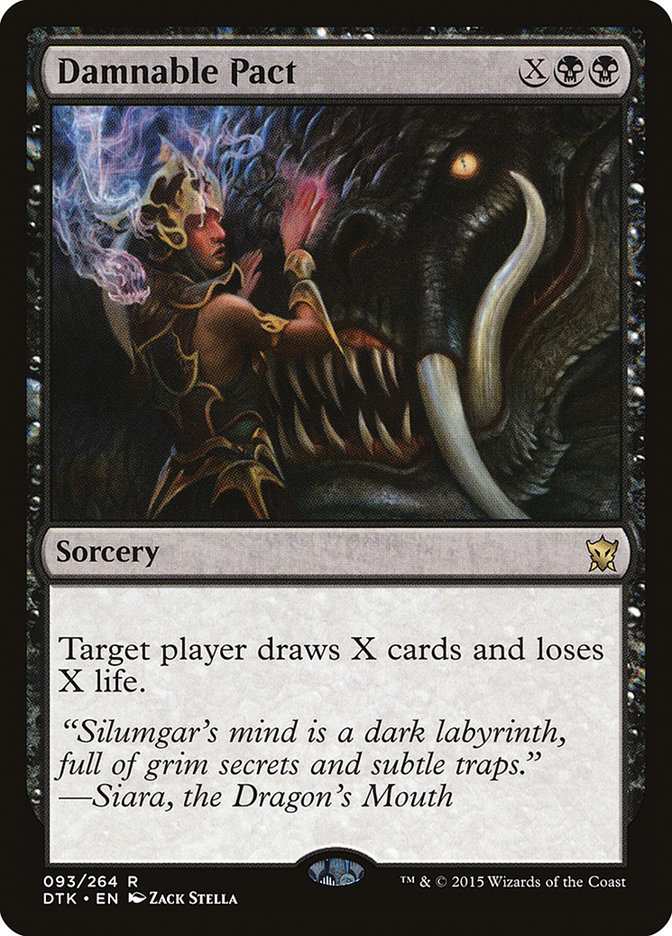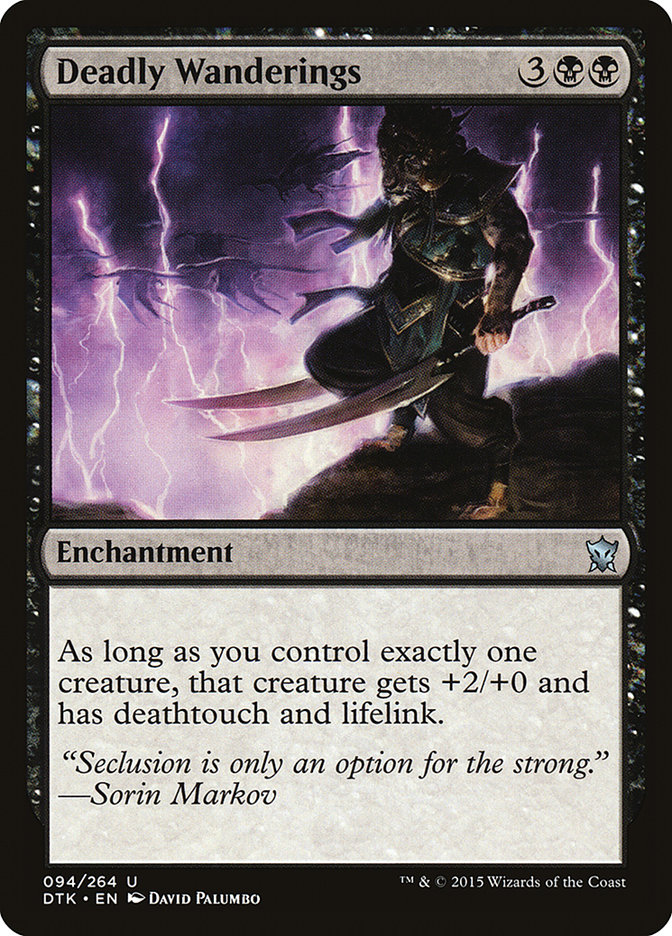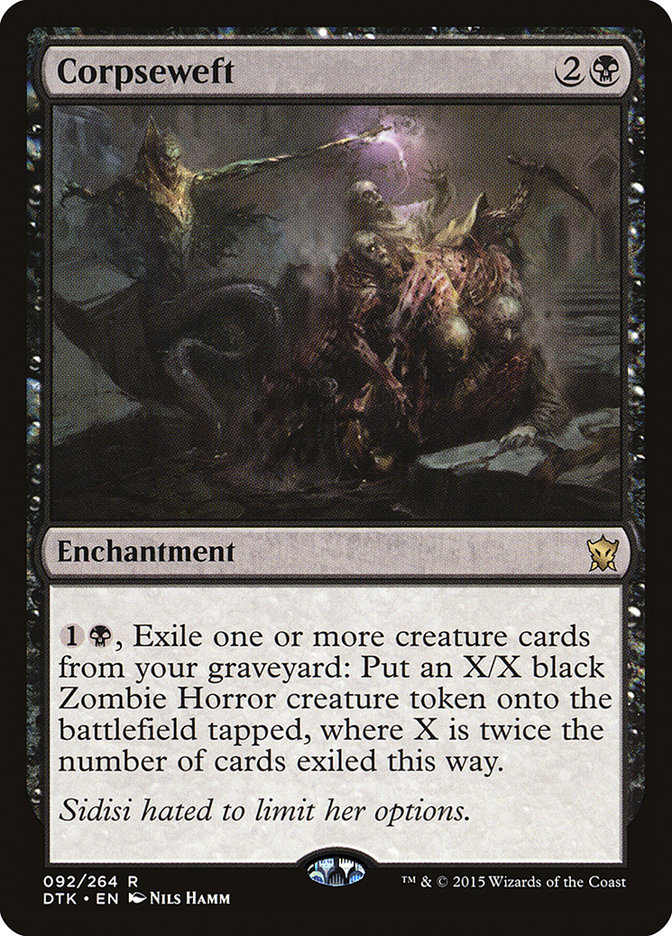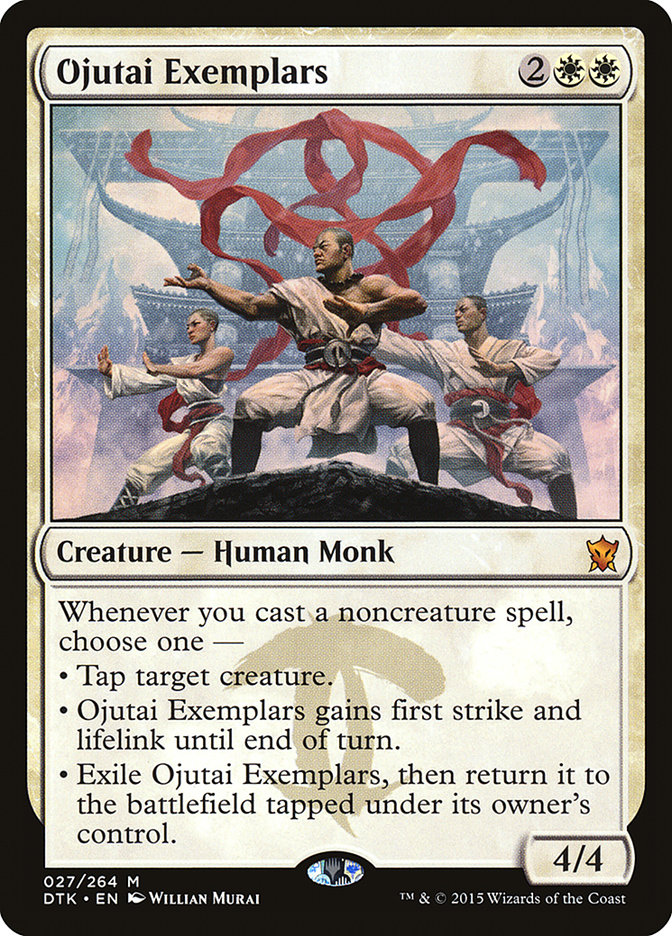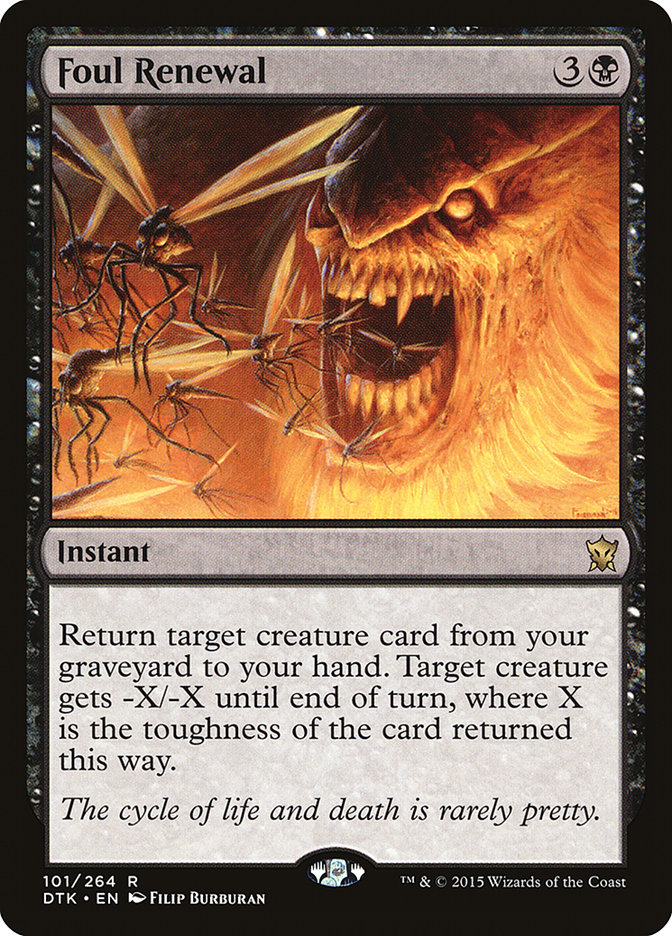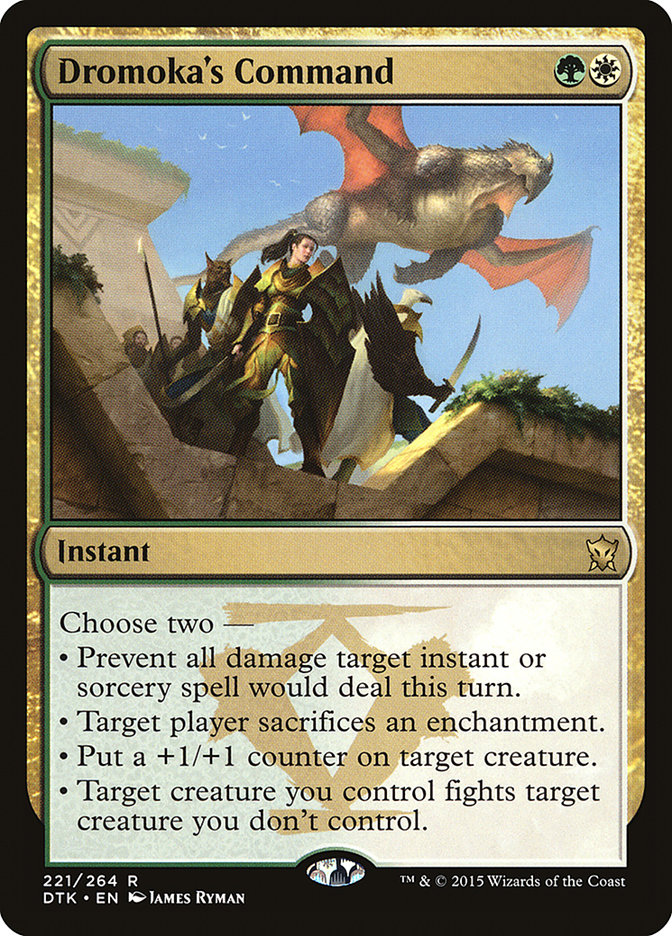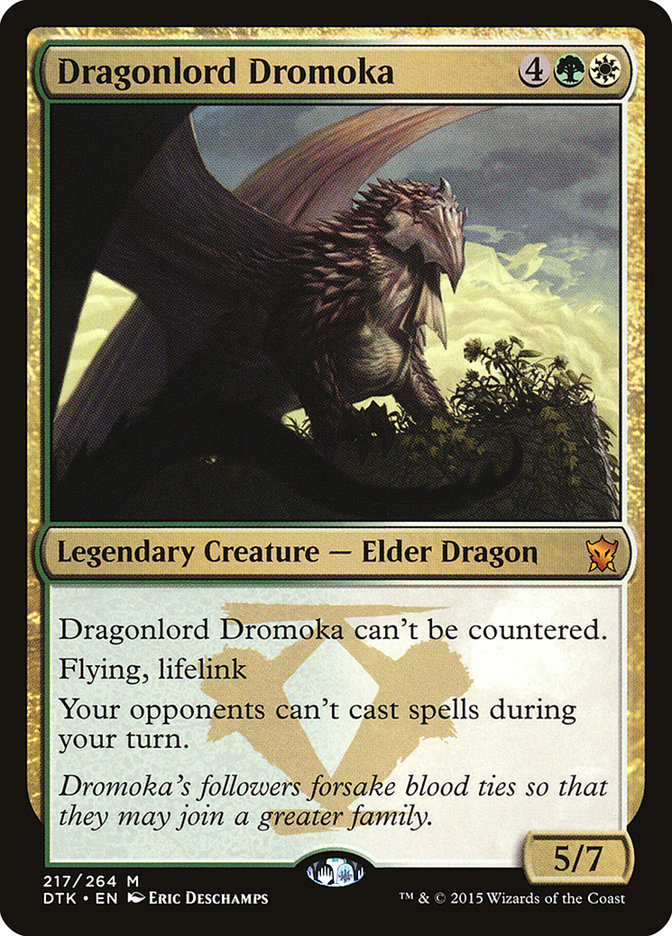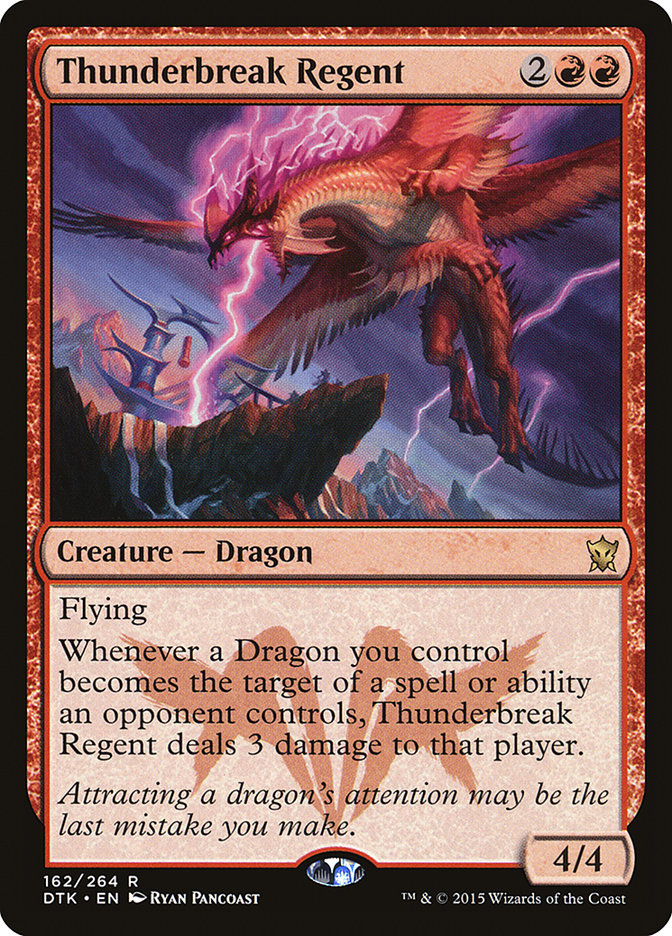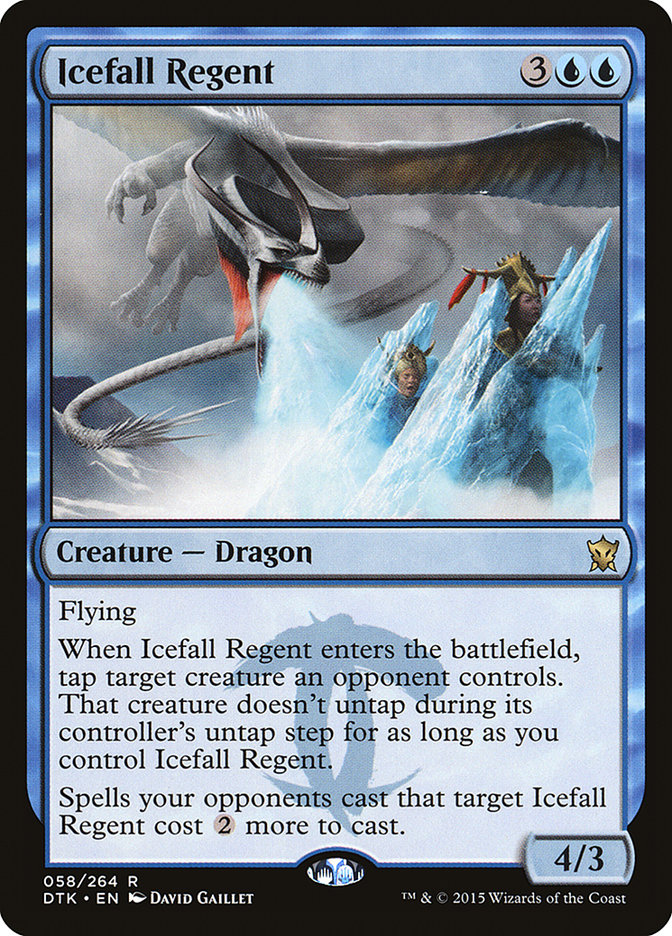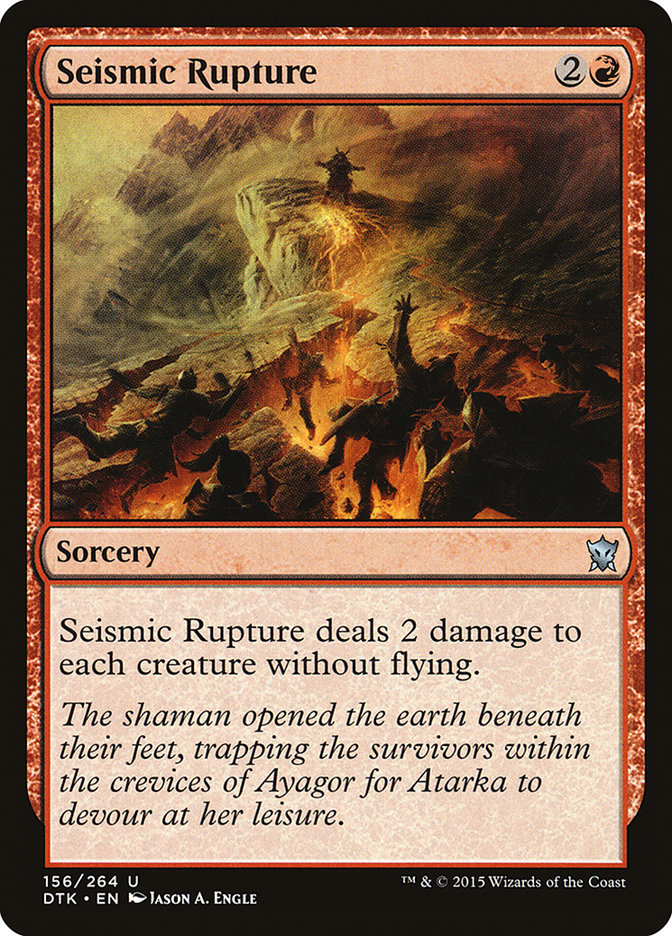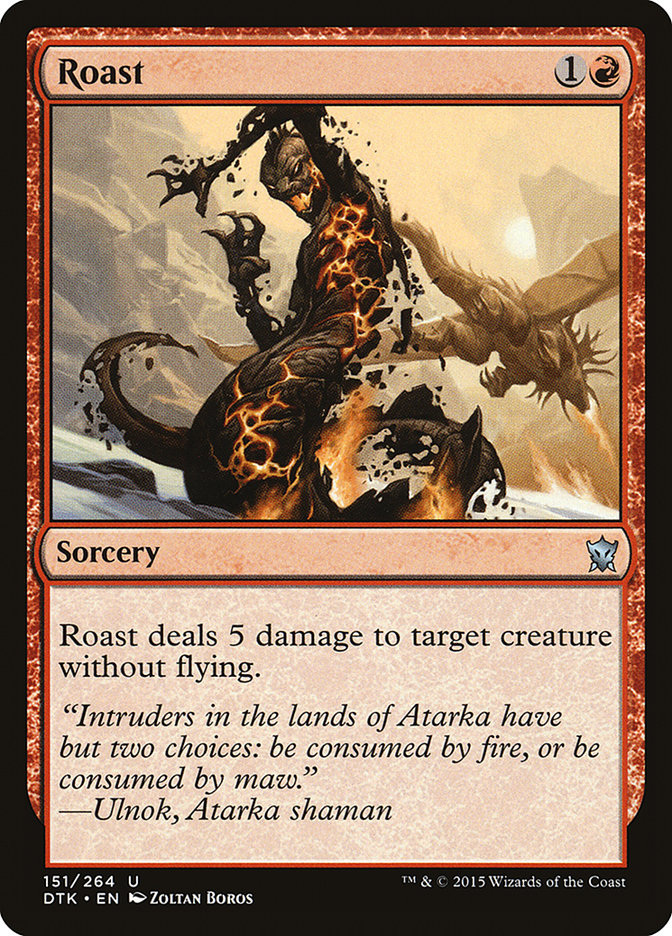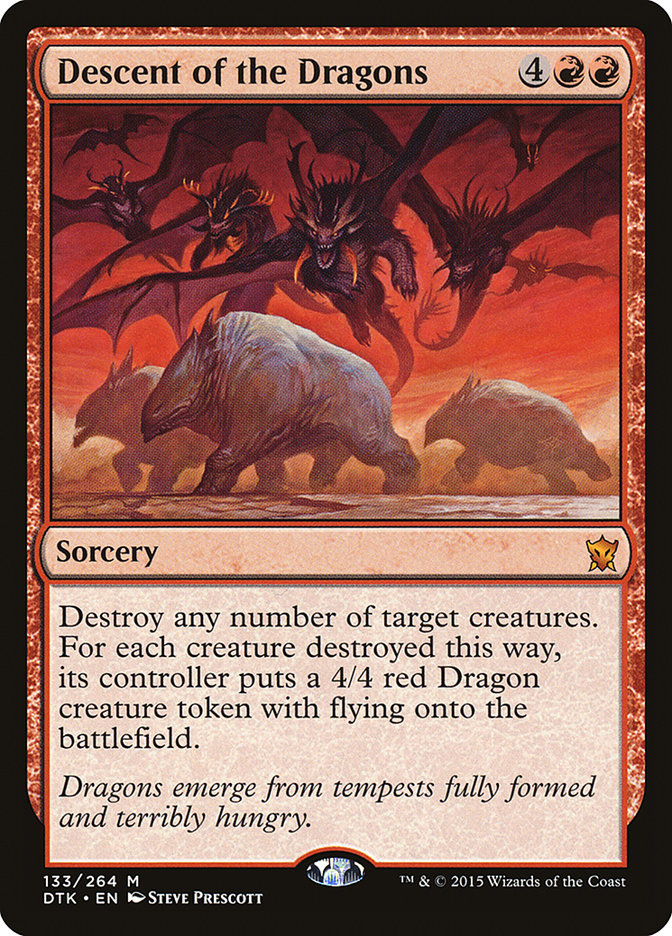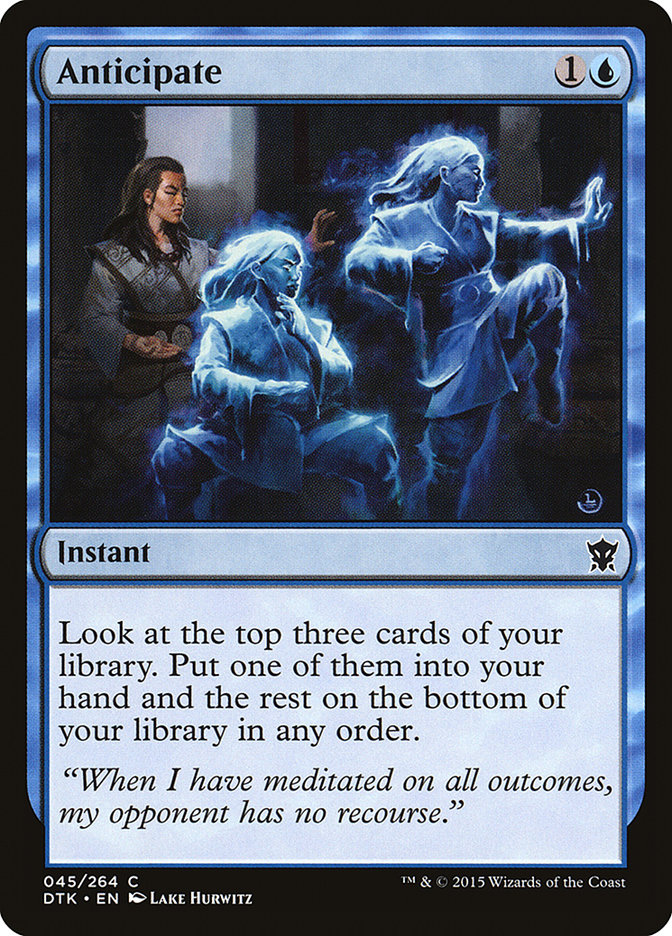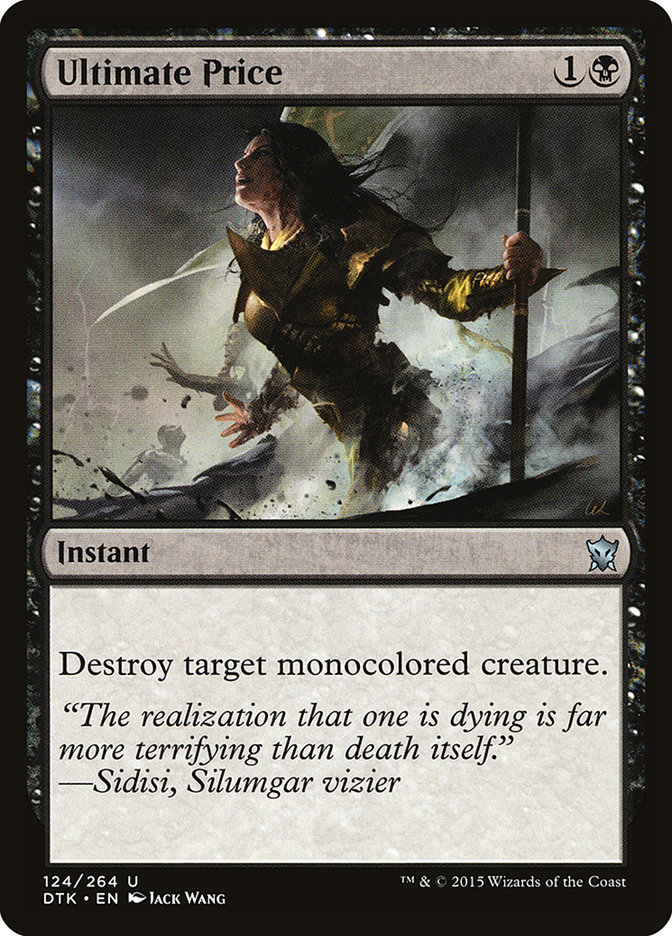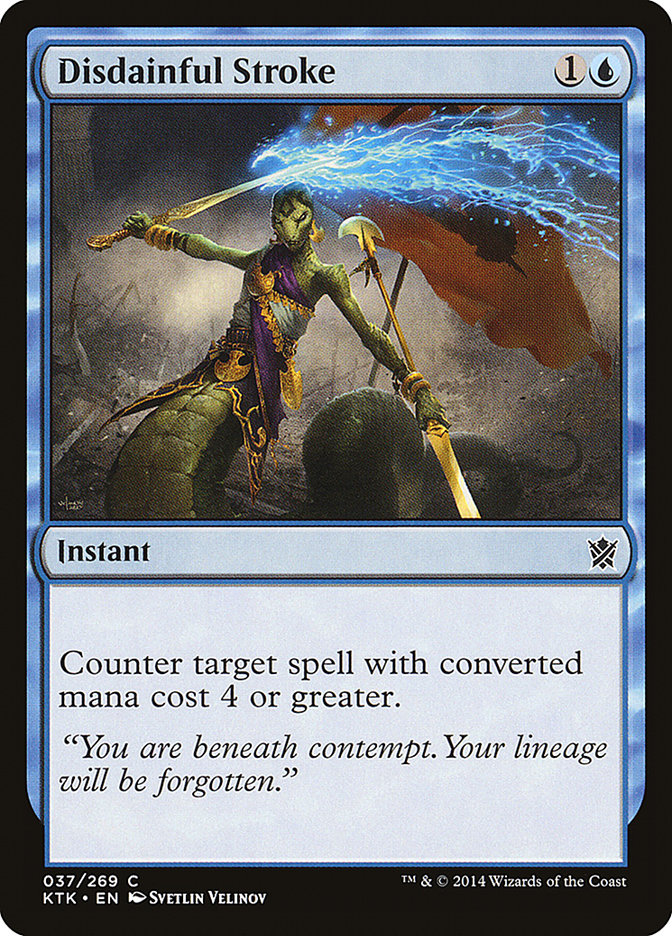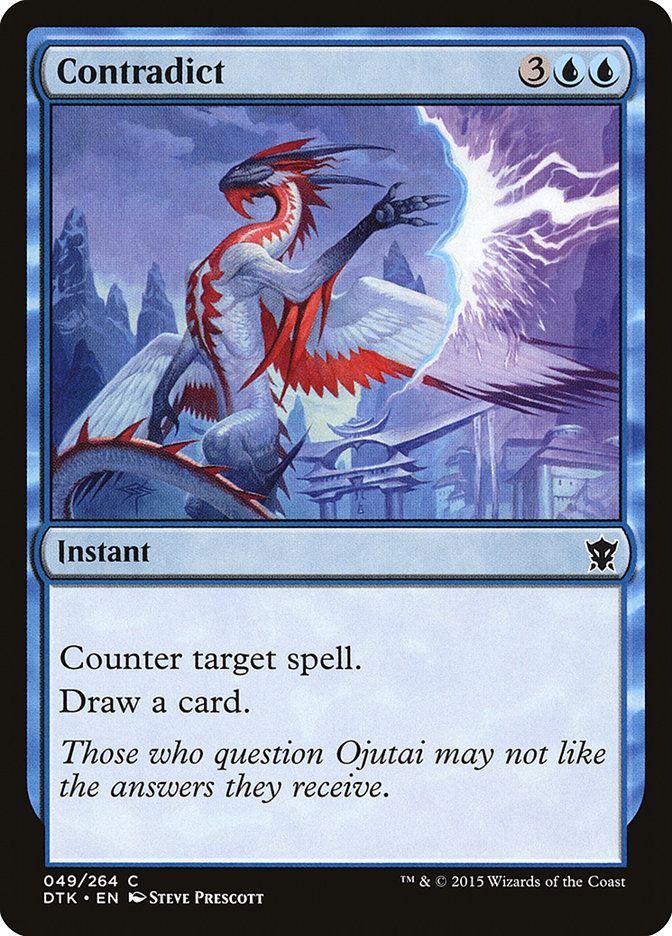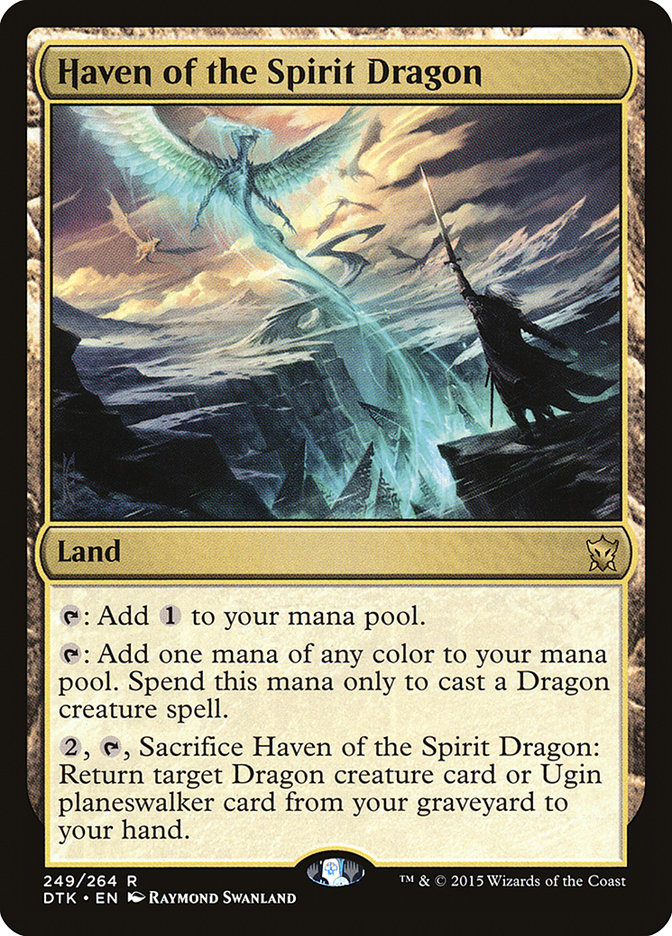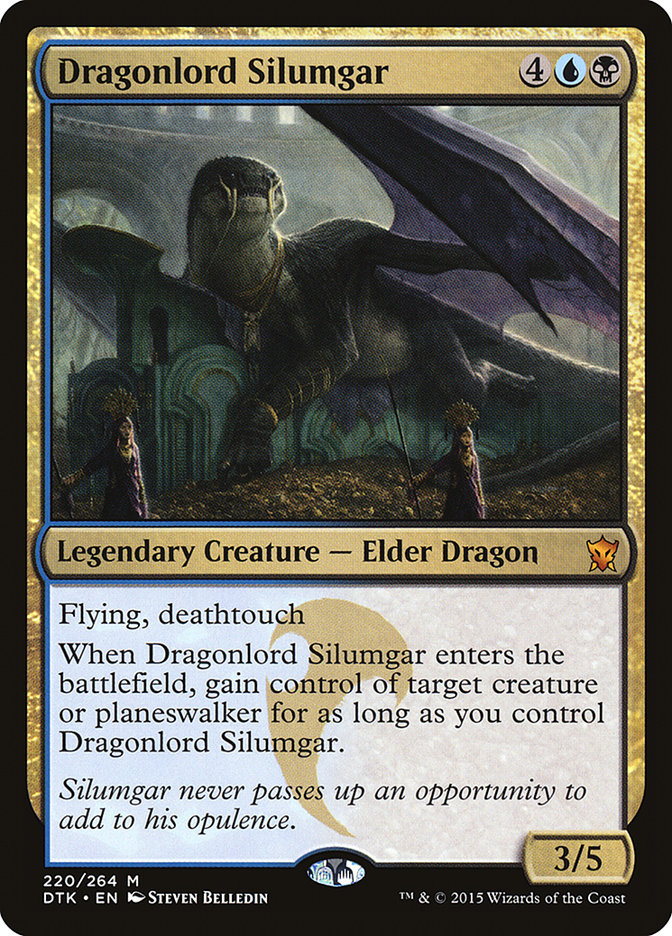Exodus
Urza’s Destiny
Judgment
Scourge
Fifth Dawn
Saviors of Kamigawa
Dissension
Coldsnap
Alara Reborn
Rise of the Eldrazi
New Phyrexia
Avacyn Restored
Dragon’s Maze
Journey into Nyx
Dragons of Tarkir
Dragons of Tarkir is the 19th and final (for the foreseeable future) third set in Magic’s history. It’s very difficult for a third set to radically change
an existing format, as it has the most other cards to compete with. Dragons of Tarkir, however, is significantly stronger and more impactful than most
third sets in Magic’s history.
Urza’s Destiny, Apocalypse, Future Sight, and New Phyrexia are the only third sets ever in the same league as Dragons of Tarkir in terms of impact and
power relative to the existing format.
This week, I’m going to be thoroughly examining Dragons of Tarkir, its impact on existing strategies, and new strategies made possible because of it. My
focus, as always, is on figuring out how best to use the new cards. We want to have every tool available to us.
Blood-Chin Fanatic is an aggressive “Warrior matters” card that can also support a black devotion theme. Outside of just providing two black mana symbols,
its ability plays right into Gray Merchant’s gameplan of draining people out.
A 3/3 for three isn’t good enough on its own, so we need to be getting paid from the tribal synergy to make Blood-Chin Fanatic worth it. However, unlike
some tribal cards, Blood-Chin Fanatic doesn’t ask you to play all warriors. The more the better, of course, but since it costs two mana each time
you use the Fanatic’s ability, the first Warrior or two you draw is more important than having all Warriors.
My favorite Blood-Chin Fanatic combo is Bloodsoaked Champion. Every turn, you can attack with the Champion, then sacrifice it to the Fanatic to drain your
opponent. Since it triggered its own raid condition, you can then bring it back to do again next turn.
My first attempt was to focus entirely on the Warrior direction. I was originally thinking it would be more of a mixture of Warriors and non-Warriors,
however, Gray Merchant was going to mean I needed a higher land counter, and Gnarled Scarhide getting downgraded to Mardu Shadowspear was a small price to
pay for Obelisk of Urd.
Creatures (27)
- 4 Tormented Hero
- 4 Mardu Skullhunter
- 4 Bloodsoaked Champion
- 4 Mardu Shadowspear
- 3 Mardu Strike Leader
- 4 Blood-Chin Fanatic
- 4 Blood-Chin Rager
Lands (23)
- 23 Swamp
Spells (10)
Sideboard

Blood-Chin Fanatic is great here, giving us finishing power after we put a lot of damage on opponents early.
Blood-Chin Rager is a less sexy payoff, to be sure, however, I think it’s better than some are giving credit for. To be interested in it, you basically
have to be Mono-Warriors, and you have to really want another cheap Warrior. Even then it is suspect; however, it does play into our strategy quite well.
It helps punch through early damage, and it helps Mardu Strike Leader actually survive combat.
Remember, it’s not like there is much competition at the two-spot for black Warriors. What are you going to use instead? Hand of Silumgar? Maybe you need
another color. Maybe you need to be humans instead of Warriors. Maybe you should just play less creatures. However, it’s useful to understand all of the
strategies that might be possible. Mono-color makes our mana better. Warriors gives us access to Blood-Chin Fanatic. Playing a lot of cheap creatures makes
Obelisk of Urd better.
Let’s walk through a normal use case comparing it to something like Pain Seer (which obviously conflicts with the Obelisk of Urd plan).
Them turn 1 – Sandsteppe Citadel
Us turn 1 – Bloodsoaked Champion
Them turn 2 – Temple of Malady
Us turn 2 – Pain Seer, attack for 2 with Bloodsoaked Champion
Them turn 3 – Courser of Kruphix
Us turn 3 – Hero’s Downfall, attack for 4 with Pain Seer and Bloodsoaked Champion
Them turn 4 – Siege Rhino
Us turn 4 – Blood-Chin Fanatic, and while we draw a card from Pain Seer, things slow down with them at 17.
Them turn 1 – Sandsteppe Citadel
Us turn 1 – Bloodsoaked Champion
Them turn 2 – Temple of Malady
Us turn 2 – Blood-Chin Rager, attack for 2 with Bloodsoaked Champion
Them turn 3 – Courser of Kruphix
Us turn 3 – Blood-Chin Fanatic, attack for 4 with Blood-Chin Rager and Bloodsoaked Champion
Them turn 4 – Siege Rhino
Us turn 4 – Hero’s Downfall the Courser of Kruphix, attack for 7. Now they’re at 10, can’t currently block anything, and we are threatening to drain them
out in a couple turns. They likely have to kill the Blood-Chin Rager before dealing with the Blood-Chin Fanatic, which is already a win for us.
Obviously there are plenty of places where Pain Seer would be better, and Pain Seer is a stronger card in the abstract. The intent was to illustrate what
it is that Blood-Chin Rager actually does. The primary reason to play Blood-Chin Rager is that it’s a Warrior, but that isn’t the only reason.
That sure is a lot of Bile Blights. I thought Ultimate Price was supposed to be great?
Ultimate Price is great. There are a lot of great black removal spells. Hero’s Downfall and Murderous Cut are pretty good too, you know? The exact
mix of removal we end up wanting is going to be a function of what other people are playing. I want to start with four Bile Blights because there is a lot
of great token making, and the 1/1 tokens are naturally very strong against Tormented Hero and the like.
This is a sick, sick sideboard card. I could even imagine metagames where decks with a lot of Sidisi, Undead Vizier action consider maindecking one. It’s
such a sick sweeper, and it actually has a fairly impressive range of applications, from Goblin Rabblemaster to Elspeth, Sun’s Champion, Master of Waves to
Hornet Queen. Even Sarkhan Unbroken is affected! Realistically, it’s far more likely to come in out of the sideboard, and maindeck Mardu Strike Leaders
basically seal the deal.
Raiders’ Spoils is another option that might be good enough, but it costs more than anything else in the deck, and we aren’t the best suited to take
advantage of the extra cards. The thing that has me giving it more thought, however, is how nice the power boost is in conjunction with Blood-Chin Fanatic
while the life loss gives us a nice way to utilize the lifegain the Fanatic is bringing to the table.
Brutal Hordechief is another four-drop and is the right type. The draining fits in nicely, but I’m guessing we need to be able to activate the Hordechief’s
brutal five-mana ability to make it worth playing Hill Giant. Once we add a bunch of painlands and tapped lands, we’re talking about a very different
animal than Mono-Black.
If I’m going to add a second color, the first one that comes to mind is white because of the number of Warrior synergies it brings to the table.
Creatures (30)
- 4 Tormented Hero
- 4 Chief of the Edge
- 4 Bloodsoaked Champion
- 4 Mardu Woe-Reaper
- 1 Hidden Dragonslayer
- 4 Arashin Foremost
- 4 Blood-Chin Fanatic
- 1 Blood-Chin Rager
- 4 Dragon Hunter
Lands (22)
Spells (8)
Sideboard

Now, this is a build all-in on the tribal synergies! In addition to Blood-Chin Fanatic, Blood-Chin Rager, and Obelisk of Urd, we have Chief of the
Edge as a “lord” and Arashin Foremost as a Silverblade Paladin for your best Warrior. We even have Mardu Woe-Reaper to gain some extra life because of your
Warriors!
Arashin Foremost is an easy one to underestimate because of small numbers on the card and a confusing ability. Remember though, the world largely
underestimated Silverblade Paladin too, and that card turned out to be five stars.
What is the difference between them? Legality aside, there are three basic differences.
● First and foremost, the Arashin only works with Warriors. You don’t have to play all Warriors, but only a Warrior is eligible for the bonus.
● Arashin Foremost’s ability only works when attacking, while Silverblade Paladin’s worked on defense as well.
● Arashin Foremost can move its ability each turn to whatever the best target is.
● Arashin Foremost’s ability can’t be disrupted by a removal spell in the middle of combat. While it is possible to use a removal spell before it attacks,
there aren’t going to be any surprises after blocks are declared. There also is no stopping the enters-the-battlefield trigger from firing.
My assessment is that the Warrior clause is a big deal and defines where Arashin Foremost can be used, but once you are playing a Warrior deck, it’s better
than Silverblade Paladin. How many Warriors do you need to play to make Arashin Foremost worth it? I don’t know yet. However, if you play all Warriors, the
card is great.
My biggest concern with Arashin Foremost and Blood-Chin Fanatic side-by-side is the mana. Needing double of each and not wanting to play many tapped lands
makes it hard. It might be foolhardy to play four copies of Mana Confluence, for instance; however, the mana is not easy here. At least we have Mardu
Woe-Reaper and Blood-Chin Fanatic to help make up for it.
Dragon Hunter is primarily just a 2/1 for one with the Warrior sub-type. It can’t block Stormbreath Dragon, dies to Silumgar, the Drifting Death, and gets
shot down by Sarkhan, the Dragonspeaker. At least it can hold off Dragonlord Silumgar or Dragonlord Dromoka once in a while.
If we decided we didn’t want so many one-drops, we could trim some Dragon Hunters and replace them with more Hidden Dragonslayers. Depending on which way
the format breaks, we might want the full playset or we might play zero.
The rate is respectable, but not crazy good or anything. The lifelink is nice, though a 2/1 body is a lot worse than a 2/2. Seeker of the Way isn’t really
appropriate with so few non-creature spells, but it is a Warrior, in case we make larger changes.
Playing Hidden Dragonslayer as a morph is a little expensive for us, as we already have plenty of threes. It can also potentially slow us down if we draw
an Obelisk on the following turn. The thing is, Hidden Dragonslayer is all about value, and that doesn’t seem like the game a B/W Warrior deck really wants
to play. I actually kind of just want more Blood-Chin Ragers if they don’t look awful in testing.
Toughness is not what we are most in the market for, but it would help if we end up facing a ton of tokens and small burn spells.
Vigilance isn’t the ability we’re really looking for either, but if we were trying to fill out a non-black Warrior list, it’s not unthinkable.
Battle Brawler hits reasonably hard, but I’m not super in love with the unreliability of the bonus, which will probably only be in effect half the time
with how much removal people play. Maybe if people start playing less this gets more attractive. In the meantime, however, I’d kind of rather just have:
Boring and mediocre, but at least it hits for three!
Okay, we did already have access to Oreskos Swiftclaw, but Dromoka Warrior is a human too. I could imagine a human Obelisk of Urd deck that has a minor
Warrior sub-theme, like maybe just Arashin Foremost and Mardu Woe-Reaper.
One possible take on Warriors is to add red and go full-on Mardu. Every time I think about an actual Mardu Warriors deck, I end up gravitating towards
Mardu Ascendancy:
Creatures (27)
- 4 Tormented Hero
- 4 Goblin Rabblemaster
- 4 Chief of the Edge
- 4 Bloodsoaked Champion
- 1 Mardu Shadowspear
- 4 Mardu Woe-Reaper
- 2 Zurgo Bellstriker
- 4 Dragon Hunter
Lands (22)
Spells (11)
Sideboard

The idea is to play a one-drop on turn 1, then two more on turn 2, then Mardu Ascendancy or Obelisk of Urd on Turn 3. This list is highly exploitable (for
instance, cast a Fleecemane Lion); however, it is an interesting exercise in looking for the extremes of the format.
This guy is getting a lot of press because of how aggressive he looks, but he’s actually aggressively mediocre. I’m not saying he’s bad, he’s just an
Isamaru with upside and two forms of downside. That he can’t block well is not a big deal. Rakdos Cackler couldn’t either. However, the legend rule does
impact our desire to play four. It’s cool that holding one in your hand because of the legend rule actually plays into the dash ability, I suppose.
Zurgo Bellstriker isn’t super impressive when you have black and white one-drops to choose from; however, he is definitely going to be a key card for
Mono-Red and nearly Mono-Red Aggro decks.
Twin Bolt is the Fire half of Fire//Ice, and that’s pretty solid. I prefer it to Arc Lightning in a deck like this because of how well it matches up
against Raise the Alarm, a card that would typically tear a deck like this apart. The two-cost is also nice for avoiding competing with Goblin
Rabblemaster, Mardu Ascendancy, and Crackling Doom on curve.
Okay, what if we cut the white cards? Could that be a thing?
Creatures (28)
- 2 Tymaret, the Murder King
- 4 Tormented Hero
- 4 Firedrinker Satyr
- 4 Goblin Rabblemaster
- 4 Bloodsoaked Champion
- 1 Brutal Hordechief
- 2 Zurgo Bellstriker
- 4 Blood-Chin Fanatic
- 3 Blood-Chin Rager
Lands (22)
Spells (10)

We’re obviously not getting much tribal synergy with this approach, but the burn really plays into the Blood-Chin Fanatic angle. Notice Firedrinker Satyr
instead of Mardu Shadowspear. It’s not like we were super needing to sacrifice the Mardu Shadowspear to the Blood-Chin Fanatic anyway. Without Obelisk or
Chief, there’s less pressure to stay devoted to the theme.
If we wanted to abandon the theme entirely, we could actually just play a red aggro deck with some black one-drops and Pitiless Horde:
Creatures (25)
- 4 Tormented Hero
- 4 Firedrinker Satyr
- 4 Gnarled Scarhide
- 4 Goblin Rabblemaster
- 4 Bloodsoaked Champion
- 2 Zurgo Bellstriker
- 3 Pitiless Horde
Lands (22)
Spells (13)
Sideboard

The number of creatures with two types makes it sometimes a fine line between one tribe and another. For instance, instead of Mono-Black Warriors, we could
go Mono-Black Humans.
Creatures (27)
- 4 Tormented Hero
- 4 Mogis's Marauder
- 4 Pain Seer
- 1 Ruthless Ripper
- 4 Bloodsoaked Champion
- 4 Mardu Shadowspear
- 4 Mardu Strike Leader
- 2 Silumgar Assassin
Lands (22)
- 22 Swamp
Spells (11)
Sideboard

This one isn’t impressive by Deathmark standards; however, it is a useful tactical weapon to have access to. It can kill a Sylvan Caryatid, a monstrous
Fleecemane Lion, or Dragonlord Ojutai. In Modern, it kills Tarmogoyf or Geist of Saint Traft, which is kind of interesting. I am hesitant to rely on it in
Standard right now, because of how poorly it fights tokens. It’s also unfortunate how many white or green decks also have Goblin Rabblemaster, which is a
really unfortunate creature to miss.
Of course, we don’t actually need to be on a tribal approach to play black aggro. The big powerhouse we gain if we abandon tribal is Pitiless Horde:
This card’s great, and in fact, the B/R deck above should probably just have Pitiless Horde instead of Blood-Chin Fanatic. It just hits so hard!
You can play it turn 3 as a legit hard-hitting threat. Yes, they can Lightning Strike it, but did they really not Lightning Strike your one or two-drop?
The Horde doesn’t end up doing all that much damage to us because of how few turns it actually sits in play (most of the time). One way or the other,
usually it dies or your opponent does.
The dash ability is where Pitiless Horde really shines. It’s not just the ability to hit for five points of haste. Sometimes your opponent has a removal
spell but taps out on their turn for something else. You can hit them with the Horde, leading them to leave their mana open, but then the Horde is back
safely in your hand. On the following turn, instead of playing into their removal, you can cast two other threats or perhaps do nothing. Similarly, the
Horde is also a good way to fight Anger of the Gods and Drown in Sorrow, which would normally be fairly effective against black aggro.
Creatures (26)
- 4 Tormented Hero
- 4 Pain Seer
- 4 Gnarled Scarhide
- 4 Bloodsoaked Champion
- 3 Mardu Shadowspear
- 3 Mardu Strike Leader
- 4 Pitiless Horde
Lands (22)
- 22 Swamp
Spells (12)
Sideboard

Silumgar Assassin is also a consideration here, but I prefer it in a more midrange strategy that appreciates the incremental advantage.
I tried building a Warriors deck with a black devotion angle, but it uncovered a number of problems that I think are inherent flaws in the concept. Gray
Merchant is higher on the curve than we’d otherwise want to play, and none of the actual black devotion cards (Merchant, Erebos, and Disciple of Phenax)
fit into the tribal. Mardu Skull-Hunter really wants you to be playing a lot of one-drops, which pulls you away from the sort of black midrange strategy
Gray Merchant wants to be a part of. Sultai Emissary is an option, but it’s not like sacrificing it to Blood-Chin Fanatic gets you far. I’d rather
sacrifice it to Sidisi, Undead Vizier.
Creatures (16)
- 4 Gray Merchant of Asphodel
- 1 Erebos, God of the Dead
- 1 Soul of Innistrad
- 4 Sultai Emissary
- 3 Sidisi, Undead Vizier
- 1 Risen Executioner
- 2 Shambling Goblin
Planeswalkers (1)
Lands (26)
Spells (17)

This list is a fairly radical departure from current mainstream black decks. How far can we take the Sidisi, Undead Vizier toolbox approach? That card
looks so powerful, I’d prefer to just have four. The thing is, black has a ton of good five-mana plays, and we haven’t even gotten to some of the
options, like Liliana Vess (which plays into the toolbox theme).
This card is crazy good.
The above is hardly the ideal home, so take that one with a grain of salt, but just on her own merits, I think Sidisi is one of the top five cards in the
set, hands down. Just being a 4/6 with deathtouch for five is already a thing, so even when we are stuck with nothing to sacrifice, it’s not like she isn’t
a force on her own. I wouldn’t be surprised if 4/6 deathtouch for four was popularly played, so she basically has to make up the mana in value (and be
ahead enough to make up for all the times you don’t get to use her ability since people can do things like Hero’s Downfall your only creature in response
to you casting Sidisi to mess with the tutor effect).
The reason Sidisi is an incredible card though, is that her effect is worth much, much more than a mana. Diabolic Tutor is rarely played at four mana, but
when it costs three mana and three life, it has been quite good. Sacrificing a creature is a cost, to be sure; however, the card you sacrificed is made up
for by not needing to use a card to tutor. The creature in play is also (probably) worth some mana since you did cast it. However, if the creature costs
less three or less mana, you are profiting compared to Grim Tutor. Additionally, if you sacrifice a creature that had an enters-the-battlefield ability or
a death trigger, you can get way ahead.
Sultai Emissary is the perfect creature to sacrifice, since it comes back stronger than before. It’s also a great blocker and resilient to opponents trying
to break up your Sidisi trigger with removal. Unfortunately, manifesting into Sidisi doesn’t give you the trigger, but she is still a big body to surprise
people with.
Shambling Goblin is great against token-based strategies and is another great creature to sacrifice. It’s also nice for building up devotion since the
Goblin is often involved in stand-offs.
Both Shambling Goblin and Sultai Emissary are Zombies, as are Sidisi and Gray Merchant.
Risen Executioner is not a trivially hard hitting threat, is great to sacrifice, helps our devotion, gives us an added angle going long, and can generate a
little card advantage once in a while. On top of all of this, the +1/+1 ability is going to be surprisingly effective at helping us put damage on opponents
we aspire to Gray Merchant out.
Not being able to block is obviously a great cost, but it’s not a dealbreaker. We have lots of blockers already, plus removal. Besides, the card hits too
hard to ignore most of the time. I wouldn’t be surprised at all to discover the card actually overperforming and warranting more than a single slot.
Finally, actual Paingeyser!
We may not have Underworld Connections anymore, but Damnable Pact is a potent replacement. If we weren’t already overflowing with expensive cards, I’d like
to see more copies in here. The second one is particularly sweet since sometimes the first one draws us so many cards, we are able to temporarily stabilize
the board but with a life total low enough that we really want to get the game over with quickly. Well, maybe we found a Nykthos and a Sidisi, letting us
generate a ton of mana so that after we find our other copy, we can point it at our opponent to finish them.
If Mono-Black Control returns, it is probably because of Damnable Pact and Sidisi giving it the power it lost when Return to Ravnica block rotated out.
I think what we’re going to find is that we need to trim some of the expensive cards for more cheap removal. For instance, we probably don’t end up using
Soul of Innistrad and Palace Siege on top of Whip of Erebos. Ultimate Price, more Bile Blights, and possibly more cheap creatures are all
reasonable options.
This card is pretty sweet, and we’d be into this sort of thing; however, there are so many other fives ahead of it in line that I’d be surprised if we
actually want to be here. Whip of Erebos and Palace Siege are better at this, and besides, we already have Gray Merchants. The thing is, Sidisi is so good,
I think we probably should be building around her more.
Seriously, I’m in love with Sidisi.
Let’s try a new take on Sultai. If you want a traditional Sultai Reanimator deck, just put 3 Sidisi, Undead Viziers in it. Remember, Sidisi, Undead Vizier
can sacrifice Sidisi, Brood Tyrant (or just chill in play with her at the same time). You cannot, however, sacrifice one Sidisi, Undead Vizier to exploit
another.
This version of Sultai seeks to exploit one of the most underrated cards in Dragons of Tarkir: Corpseweft.
Creatures (24)
- 4 Sylvan Caryatid
- 4 Courser of Kruphix
- 4 Satyr Wayfinder
- 1 Reclamation Sage
- 4 Sidisi, Brood Tyrant
- 2 Tasigur, the Golden Fang
- 2 Torrent Elemental
- 3 Sidisi, Undead Vizier
Lands (23)
Spells (13)

Two elements of Corpseweft that intrigue me are the fact that it gives you a creature twice as big as the number you exile, and the fact that it doesn’t
cost extra mana no matter how many creatures you exile.
So, how much do we need to get out of Corpseweft before we are getting a good deal?
Well, if we think of it as a five-drop that comes down and exiles three creatures from our graveyard, we end up with a 6/6 and have a Corpseweft
in play. Three creatures is not hard to come by, and often we will have quite a few more. I don’t know that we have to move entirely away from Whip of
Erebos, but Corpseweft seems really powerful to me.
One great interaction we have at our disposal is the combination with Torrent Elemental. Torrent Elemental was already an interesting card in decks like
this because of its ability to rebuy itself whenever you can get it into exile. Corpseweft lets us exile it every time it dies while also advancing our
board!
Now, Pharika, God of Affliction could already do this, but think about the kind of turn 5 play Pharika is compared to Corpseweft. That’s the main thing
Corpseweft has going for it.
I would guess that just sliding Corpseweft in place of Whip of Erebos isn’t the best way to use the card, but it’s such a strange and new card, it’s hard
to really gauge how best to use it until we get some experience with it.
While Sidisi is going to be amazing in some decks, she is so powerful of a card, I think she’s going to show up in a lot of decks without having a specific
reason. For instance:
Creatures (14)
- 2 Brimaz, King of Oreskos
- 4 Seeker of the Way
- 4 Monastery Mentor
- 2 Sidisi, Undead Vizier
- 2 Ojutai Exemplars
Planeswalkers (3)
Lands (25)
Spells (18)

This list doesn’t feature much of a toolbox, but it wants a couple five-drops, and Sidisi might be a better option than Wingmate Roc.
I have heard such polar extremes on this card, but I actually think it’s closer to the middle. It’s a good card, but it’s not format-defining and certainly
not unplayable. It can really take over a game going long, holding off an entire army, gaining life, and protecting itself from removal. You’re not always
going to have the mana or spells to protect it, but being stuck with a 4/4 for four is not the worst fail state. How best to use the card once it is in
play is a more in-depth subject than the scope of this article, but you can think of it like all of your instants are charms. Also, a good rule of thumb is
to use your Thoughtseizes and Read the Bones for lifelink.
One of the keys to making it work is the use of cheap instants that you can actually use to protect it. Raise the Alarm is perfect for this (and Monastery
Mentor and Seeker of the Way) while also providing fuel for Sidisi. Brimaz, Monastery Mentor, Elspeth, and Sorin can all contribute tokens to eat as well,
and if you end up having to occasionally exploit a Seeker of the Way, that’s not the end of the world.
Another possible home for Sidisi is in Abzan Midrange:
Creatures (19)
- 1 Hornet Queen
- 3 Sylvan Caryatid
- 4 Courser of Kruphix
- 4 Satyr Wayfinder
- 4 Siege Rhino
- 1 Tasigur, the Golden Fang
- 2 Sidisi, Undead Vizier
Planeswalkers (1)
Lands (24)
Spells (16)

I’m not sure how I feel about Sylvan Caryatid with Sidisi. It is nice to be able to convert the Caryatid into something useful later, but I’m a little
concerned about flooding out too much if we play 24 lands and this many mana creatures.
This one is a wildly speculative experiment. It is probably just going to become another Hero’s Downfall; however, I could imagine a world where Foul
Renewal is actually solid. It is a two-for-one and very good at winning Siege Rhino wars. It’s does cool things with Satyr Wayfinder and is actually a
respectable tutor target, threatening to get Sidisi back if they kill her while also killing your opponent’s best creature. It even kills Thassa!
Of course, Hero’s Downfall is pretty good too, so there’s a high bar.
This is a very versatile and efficient Magic card. You’re generally going to want some or a lot of these in every G/W creature deck somewhere in the 75.
Abzan Advantage was already a high level Constructed card, and Dromoka’s Command has a lot of other abilities:
● The ability to start fights works very well with the +1/+1 counter and is often going to function as removal.
● The ability to prevent damage from spells can stop a timely Stoke the Flames or Lightning Strike that was trying to finish off your Siege Rhino after
combat.
● The +1/+1 counter can go anywhere, not just on your lowest toughness creature.
While Dromoka’s Command is totally fine in Abzan Midrange, it’s downright excellent in Abzan Aggro:
Creatures (18)
- 4 Fleecemane Lion
- 4 Anafenza, the Foremost
- 4 Rakshasa Deathdealer
- 4 Siege Rhino
- 2 Warden of the First Tree
Planeswalkers (2)
Lands (24)
Spells (16)

You are often going to be able to get two cards out of Dromoka’s Command, or a card with some value. For instance, you can have your Siege Rhino fight a
Fleecemane Lion while they sacrifice their Courser of Kruphix as an enchantment. You can also have your Lion fight a Rabblemaster while destroying an
Outpost Siege. You can save your Lion from a Lightning Strike while picking off a Soulfire Grand Master. You can even save two creatures from an Anger of
the Gods!
This is probably a bit too expensive for this list, but I want to try this card lots of places. It can function like a massive Baneslayer Angel that is
extremely hard to burn, but it’s also an uncounterable threat that doesn’t die to Bile Blight or Ultimate Price.
Speaking of Dragons…
Creatures (23)
- 4 Sylvan Caryatid
- 4 Courser of Kruphix
- 1 Dragonlord Silumgar
- 1 Dragonlord Atarka
- 4 Scaleguard Sentinels
- 4 Thunderbreak Regent
- 1 Dragonlord Dromoka
- 1 Dragonlord Kolaghan
- 1 Dragonlord Ojutai
- 2 Icefall Regent
Planeswalkers (2)
Lands (26)
Spells (9)

Eleven Dragons?
That’s ridiculous. But there are a lot of quality reasons to play Dragons, and I wonder how far you can push it. It is not a natural thing for a deck to
want to play so many fatties, but it is pretty sweet to get to play with Counterspell, a Searing Blaze, and a 3/4 for two.
As good as all that is, I think Dragon Tempest might actually be the reason to do the Dragon-thing in hardcore mode. Dragons that can attack immediately
kill a lot faster. Besides, Dragon Tempest is actually a form of removal, letting you pick off creatures or just go to the dome for more damage. It’s okay
to draw two, since they do stack, though the second instance of haste is wasted.
The mana is a challenge, and we probably need to play more cheap removal, and perhaps more accelerators, like Rattleclaw Mystic. Dragonlord Ojutai is the
oddball among the Dragonlords and might not deserve a place. Of course, once we start thinking such thoughts, I start wanting more Dragonlord Silumgars.
Even though it’s a legend, Silumgar is just absurd, particularly when you have other must kill creatures. Top five card in the set in my estimation.
I am excited about how easy Haven of the Spirit Dragon makes it to cast whatever Dragons we want when used alongside Sylvan Caryatid and Sarkhan Unbroken.
It’s very possible we want more Crucible of the Spirit Dragon action too, but the card is so much weaker than Haven of the Spirit Dragon, I wanted to be
careful about going too far down that path.
Costing three is pretty brutal. That it is an instant gives it a chance, but I am not optimistic.
It’s nice to have some “early” creatures to get the party started. It’s also kind of sweet that it makes it hard for people to go after your other Dragons
before dealing with it.
I prefer Icefall Regent to Stormbreath Dragon here for two reasons. First, it helps give us a better plan against creatures too big to kill with Draconic
Roar or Dragon Tempest. It gains this ability at the expense of haste, but Dragon Tempest gives us haste anyway. Second, opposing removal spells costing
two extra to kill it can have a serious impact on our opponent’s tempo. Maybe it ends up that missing the protection from white or the fourth point of
toughness takes us back to Stormbreath, but I’d rather start with the new card. You learn more that way, you know?
Its special ability is that it doesn’t kill your Sylvan Caryatid!
A much needed answer to fatties like Siege Rhino and Tasigur, the Golden Fang.
In thinking about ways to improve the mana, I wonder what it’d look like to cut green (and white)?
Creatures (12)
Lands (26)
Spells (22)

Foul-Tongue Invocation is a pretty sweet reason to play Dragons, but I’m not sure you actually have to play this many Dragons to play the Dragon-reveal
cards. Depending on which ones you play and your strategy, I could imagine 4-8 actually being enough for some decks.
Crux of Fate is obviously a fun one for Dragon tribal decks since it starts becoming something of a functional Plague Wind.
The sideboard Dragon Tempest is primarily against decks with sweepers, but there’s a good chance it should just be another cheap interactive card, or
perhaps another Dragonlord’s Prerogative.
Stripping things down even further, we could go to:
Creatures (11)
Lands (26)
Spells (23)

This approach might be okay, but it doesn’t get to use Dragon Tempest, which is the card I actually want to work with. Perhaps the secret to Dragon Tempest
is to use it as a combo card and not worry so much about having a lot of dragons. For instance…
Creatures (13)
Lands (25)
Spells (22)

If you have Dragon Tempest in play when you cast Descent of Dragons for at least three (perhaps on a Hordeling Outburst), you get three triggers for three
damage each, plus you have three 4/4 flying haste dragons. That’s 21 damage, right there!
Okay, I’m out for today, but I will be back Wednesday to pick up where we left off. Let me know what cards or decks you want to see discussed!
Whoa, whoa, whoa. Aren’t you forgetting something?
I don’t think so.
What about your roots?
We got a Grixis deck in there, didn’t we?
Your other roots.
Mono-Red? Today’s focus was black.
Are you really telling me there’s not a single control deck that can be built with black cards?
Nah, it’s not even like that. I want to discuss the control decks with blue or else we’re never getting out of here today.
You’re not getting out of here without making at least one control deck, and “blocks-with-dragons-control” does not count.
Okay, geez, no need to get so aggressive…
Creatures (2)
Planeswalkers (3)
Lands (26)
Spells (29)

Anticipate makes it possible to play less lands and less card drawers since we have so much more ability to go look for Dig Through Time. The card is great
and is probably the best cheap library manipulation since the Ponder/Preordain era.
Ultimate Price is good, but I actually slightly prefer Bile Blight, I think. That said, having access to more than four two mana removal spells is a major
advancement.
I am unsure on Disdainful Stroke at the moment. I could easily imagine it being less safe of a maindeck card now that there are so many good cheap plays
and so many decks possible that don’t rely on any fours or up. As a result, I am trying to hedge with Negate and Thoughtseize, but that might not be
realistic either.
Seems too expensive. I’d probably play a Silumgar’s Command over it. If the format slowed down enough to make this attractive, I’d probably just want more
card draw like Cruise/Dig/Prerogative and more cheap interaction like Seize/Stroke/Negate.
It’s a nice option going long, being able to trade one of your lands for a quality spell that can actually win the game.
Talk about an amazing way to punish people that take out some removal, but even against people with removal, the combination of Thoughtseize and Negate can
make it hard to kill Silumgar. Besides, he naturally beats Stoke the Flames, Ultimate Price, and Bile Blight, so it’s not like he’s trivial to kill or
anything.
Okay, now I’m out for realz. [sic]
See you Wednesday!


